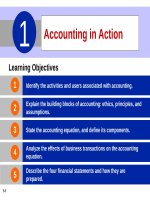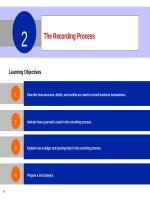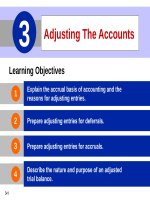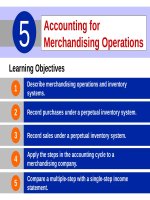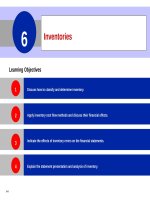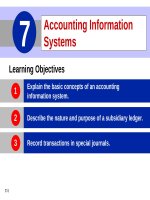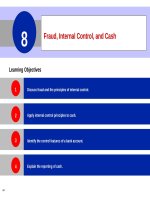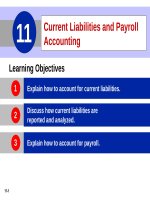Accounting principles 12th willey kieso chapter 08
Bạn đang xem bản rút gọn của tài liệu. Xem và tải ngay bản đầy đủ của tài liệu tại đây (1.93 MB, 70 trang )
8
Fraud, Internal Control, and Cash
Learning Objectives
8-1
1
Discuss fraud and the principles of internal control.
2
Apply internal control principles to cash.
3
Identify the control features of a bank account.
4
Explain the reporting of cash.
LEARNING
OBJECTIVE
1
Discuss fraud and the principles of internal control.
Fraud
Dishonest act by an employee that results in personal benefit to the employee at a cost to the employer.
Three factors that contribute to
fraudulent activity.
Illustration 8-1
Fraud triangle
8-2
LO 1
The Sarbanes-Oxley Act
Applies to publicly traded U.S. corporations.
Required to maintain a system of internal control.
Corporate executives and boards of directors must ensure that these controls are reliable and
effective.
8-3
Independent outside auditors must attest to the adequacy of the internal control system.
SOX created the Public Company Accounting Oversight Board (PCAOB).
LO 1
Internal Control
Methods and measures adopted to:
8-4
●
Safeguard assets.
●
Enhance the reliability of accounting records.
●
Increase efficiency of operations.
●
Ensure compliance with laws and regulations.
LO 1
Internal Control
Five Primary Components:
8-5
●
A control environment.
●
Risk assessment.
●
Control activities.
●
Information and communication.
●
Monitoring.
LO 1
People, Planet, and Profit Insight
And the Controls Are . . .
Internal controls are important for an effective financial reporting system. The same is true for sustainability reporting. An effective system
of internal controls for sustainability reporting will help in the following ways: (1) prevent the unauthorized use of data; (2) provide
reasonable assurance that the information is accurate, valid, and complete; and (3) report information that is consistent with overall
sustainability accounting policies. With these types of controls, users will have the confidence that they can use the sustainability
information effectively. Some regulators are calling for even more assurance through audits of this information. Companies that potentially
can cause environmental damage through greenhouse gases, as well as companies in the mining and extractive industries, are subject
to reporting requirements. And, as demand for more information in the sustainability area expands, the need for audits of this information
will grow.
Why is sustainability information important to investors? (Go to WileyPLUS for this answer and additional questions.)
8-6
LO 1
Principles of Internal Control Activities
ESTABLISHMENT OF RESPONSIBILITY
Control is most effective when only one person is
responsible for a given task.
Establishing responsibility often requires limiting access only
to authorized personnel, and then identifying those
personnel.
8-7
LO 1
ANATOMY OF A FRAUD
Maureen Frugali was a training supervisor for claims processing at Colossal Healthcare. As a standard part of the claims processing
training program, Maureen created fictitious claims for use by trainees. These fictitious claims were then sent to the accounts payable
department. After the training claims had been processed, she was to notify Accounts Payable of all fictitious claims, so that they would
not be paid. However, she did not inform Accounts Payable about every fictitious claim. She created some fictitious claims for entities
that she controlled (that is, she would receive the payment), and she let Accounts Payable pay her.
Total take: $11 million
The Missing Control
Establishment of responsibility. The healthcare company did not adequately restrict the responsibility for authoring and approving
claims transactions. The training supervisor should not have been authorized to create claims in the company’s “live” system.
8-8
LO 1
Principles of Internal Control Activities
SEGREGATION OF DUTIES
Different individuals should be responsible for related
activities.
The responsibility for record-keeping for an asset should
be separate from the physical custody of that asset.
8-9
LO 1
ANATOMY OF A FRAUD
Lawrence Fairbanks, the assistant vice-chancellor of communications at Aesop University, was allowed to make purchases of under
$2,500 for his department without external approval. Unfortunately, he also sometimes bought items for himself, such as expensive
antiques and other collectibles. How did he do it? He replaced the vendor invoices he received with fake vendor invoices that he
created. The fake invoices had descriptions that were more consistent with the communications department’s purchases. He submitted
these fake invoices to the accounting department as the basis for their journal entries and to the accounts payable department as the
basis for payment.
Total take: $475,000
The Missing Control
Segregation of duties. The university had not properly segregated related purchasing activities. Lawrence was ordering items,
receiving the items, and receiving the invoice. By receiving the invoice, he had control over the documents that were used to account for
the purchase and thus was able to substitute a fake invoice.
8-10
LO 1
ANATOMY OF A FRAUD
Angela Bauer was an accounts payable clerk for Aggasiz Construction Company. She prepared and issued checks to vendors and
reconciled bank statements. She perpetrated a fraud in this way: She wrote checks for costs that the company had not actually incurred
(e.g., fake taxes). A supervisor then approved and signed the checks. Before issuing the check, though, she would “white-out” the payee
line on the check and change it to personal accounts that she controlled. She was able to conceal the theft because she also reconciled
the bank account. That is, nobody else ever saw that the checks had been altered.
Total take: $570,000
The Missing Control
Segregation of duties. Aggasiz Construction Company did not properly segregate record-keeping from physical custody. Angela had
physical custody of the checks, which essentially was control of the cash. She also had record-keeping responsibility because she
prepared the bank reconciliation.
8-11
LO 1
Principles of Internal Control Activities
DOCUMENTATION PROCEDURES
Companies should use prenumbered documents, and
all documents should be accounted for.
Employees should promptly forward source documents
for accounting entries to the accounting department.
8-12
LO 1
ANATOMY OF A FRAUD
To support their reimbursement requests for travel costs incurred, employees at Mod Fashions Corporation’s design center were required
to submit receipts. The receipts could include the detailed bill provided for a meal, or the credit card receipt provided when the credit card
payment is made, or a copy of the employee’s monthly credit card bill that listed the item. A number of the designers who frequently
traveled together came up with a fraud scheme: They submitted claims for the same expenses. For example, if they had a meal together
that cost $200, one person submitted the detailed meal bill, another submitted the credit card receipt, and a third submitted a monthly
credit card bill showing the meal as a line item. Thus, all three received a $200 reimbursement.
Total take: $75,000
The Missing Control
Documentation procedures. Mod Fashions should require the original, detailed receipt. It should not accept photocopies, and it should
not accept credit card statements. In addition, documentation procedures could be further improved by requiring the use of a corporate
credit card (rather than a personal credit card) for all business expenses.
8-13
LO 1
Principles of Internal Control Activities
PHYSICAL CONTROLS
Illustration 8-2
8-14
LO 1
ANATOMY OF A FRAUD
At Centerstone Health, a large insurance company, the mailroom each day received insurance applications from prospective customers.
Mailroom employees scanned the applications into electronic documents before the applications were processed. Once the applications
are scanned they can be accessed online by authorized employees. Insurance agents at Centerstone Health earn commissions based
upon successful applications. The sales agent’s name is listed on the application. However, roughly 15% of the applications are from
customers who did not work with a sales agent. Two friends—Alex, an employee in record keeping, and Parviz, a sales agent—thought up
a way to perpetrate a fraud. Alex identified scanned applications that did not list a sales agent. After business hours, he entered the
mailroom and found the hardcopy applications that did not show a sales agent. He wrote in Parviz’s name as the sales agent and then
rescanned the application for processing. Parviz received the commission, which the friends then split.
Total take: $240,000
The Missing Control
8-15
LO 1
Total take: $240,000
The Missing Control
Physical controls. Centerstone Health lacked two basic physical controls that could have prevented this fraud. First, the mailroom
should have been locked during nonbusiness hours, and access during business hours should have been tightly controlled. Second, the
scanned applications supposedly could be accessed only by authorized employees using their passwords. However, the password for
each employee was the same as the employee’s user ID. Since employee user-ID numbers were available to all other employees, all
employees knew all other employees’ passwords. Unauthorized employees could access the scanned applications. Thus, Alex could
enter the system using another employee’s password and access the scanned applications.
8-16
LO 1
Principles of Internal Control Activities
INDEPENDENT INTERNAL VERIFICATION
Records periodically verified by an
employee who is independent.
Discrepancies reported to
management.
Illustration 8-3
Comparison of segregation of duties principle with independent
internal
verification principle
8-17
LO 1
ANATOMY OF A FRAUD
Bobbi Jean Donnelly, the office manager for Mod Fashions Corporations design center, was responsible for preparing the design center
budget and reviewing expense reports submitted by design center employees. Her desire to upgrade her wardrobe got the better of her,
and she enacted a fraud that involved filing expense-reimbursement requests for her own personal clothing purchases. She was able to
conceal the fraud because she was responsible for reviewing all expense reports, including her own. In addition, she sometimes was given
ultimate responsibility for signing off on the expense reports when her boss was “too busy.” Also, because she controlled the budget, when
she submitted her expenses, she coded them to budget items that she knew were running under budget, so that they would not catch
anyone’s attention.
Total take: $275,000
The Missing Control
Independent internal verification. Bobbi Jean’s boss should have verified her expense reports. When asked what he thought her
expenses were, the boss said about $10,000. At $115,000 per year, her actual expenses were more than ten times what would have
been expected. However, because he was “too busy” to verify her expense reports or to review the budget, he never noticed.
8-18
LO 1
Principles of Internal Control Activities
HUMAN RESOURCE CONTROLS
8-19
Bond employees who handle cash.
Rotate employees’ duties and require vacations.
Conduct background checks.
LO 1
ANATOMY OF A FRAUD
Ellen Lowry was the desk manager and Josephine Rodriquez was the head of housekeeping at the Excelsior Inn, a luxury hotel. The two
best friends were so dedicated to their jobs that they never took vacations, and they frequently filled in for other employees. In fact, Ms.
Rodriquez, whose job as head of housekeeping did not include cleaning rooms, often cleaned rooms herself, “just to help the staff keep
up.” Ellen, the desk manager, provided significant discounts to guests who paid with cash. She kept the cash and did not register the guest
in the hotel’s computerized system. Instead, she took the room out of circulation “due to routine maintenance.” Because the room did not
show up as being used, it did not receive a normal housekeeping assignment. Instead, Josephine, the head of housekeeping, cleaned the
rooms during the guests’ stay.
Total take: $95,000
The Missing Control
Human resource controls. Ellen, the desk manager, had been fired by a previous employer. If the Excelsior Inn had conducted a
background check, it would not have hired her. The fraud was detected when Ellen missed work due to illness. A system of mandatory
vacations and rotating days off would have increased the chances of detecting the fraud before it became so large.
8-20
LO 1
Accounting Across the Organization
SOX Boosts the Role of Human Resources
Under SOX, a company needs to keep track of employees’ degrees and certifications to ensure that employees continue to
meet the specified requirements of a job. Also, to ensure proper employee supervision and proper separation of duties,
companies must develop and monitor an organizational chart. When one corporation went through this exercise, it found
that out of 17,000 employees, there were 400 people who did not report to anyone. The corporation also had 35 people who
reported to each other. In addition, if an employee complains of an unfair firing and mentions financial issues at the
company, HR should refer the case to the company audit committee and possibly to its legal counsel.
Why would unsupervised employees or employees who report to each other represent potential internal control threats?
(Go to WileyPLUS for this answer and additional questions.)
8-21
LO 1
Limitations of Internal Control
Costs should not exceed benefit.
Human element.
Size of the business.
Helpful Hint
Controls may vary with the risk level of the activity.
For example, management may consider cash to be
high risk and maintaining inventories in the stockroom
as lower risk. Thus, management would have stricter
controls for cash.
8-22
LO 1
DO IT!
1
Control Activities
Identify which control activity is violated in each of the following situations, and explain how the situation creates an
opportunity for a fraud.
1.
The person with primary responsibility for reconciling the bank account and making all bank deposits is also the
company’s accountant.
Solution
8-23
Violates the control activity of segregation of duties.
Recordkeeping should be separate from physical custody.
Employee could embezzle cash and make journal entries to hide the theft.
LO 1
DO IT!
1
Control Activities
Identify which control activity is violated in each of the following situations, and explain how the situation creates an
opportunity for a fraud.
2.
Wellstone Company’s treasurer received an award for distinguished service because he had not taken a
vacation in 30 years.
Solution
8-24
Violates the control activity of human resource controls.
Key employees must take vacations.
Treasurer, who manages the company’s cash, might embezzle cash and use his position to conceal the theft.
LO 1
DO IT!
1
Control Activities
Identify which control activity is violated in each of the following situations, and explain how the situation creates an
opportunity for a fraud.
3.
In order to save money spent on order slips and to reduce time spent keeping track of order slips, a local
bar/restaurant does not buy prenumbered order slips.
Solution
Violates the control activity of documentation procedures.
If prenumbered documents are not used, then it is virtually impossible to account for the documents.
An employee could write up a dinner sale, receive cash from the customer, and then throw away the order slip
and keep the cash.
8-25
LO 1

